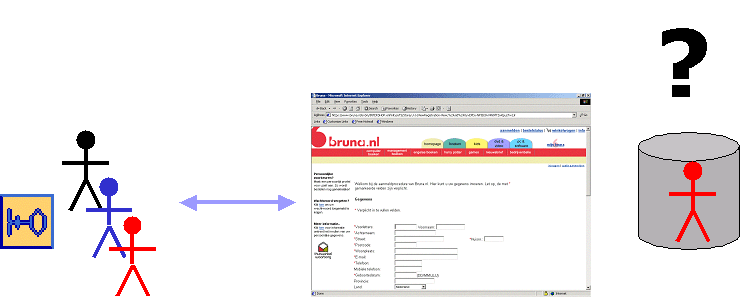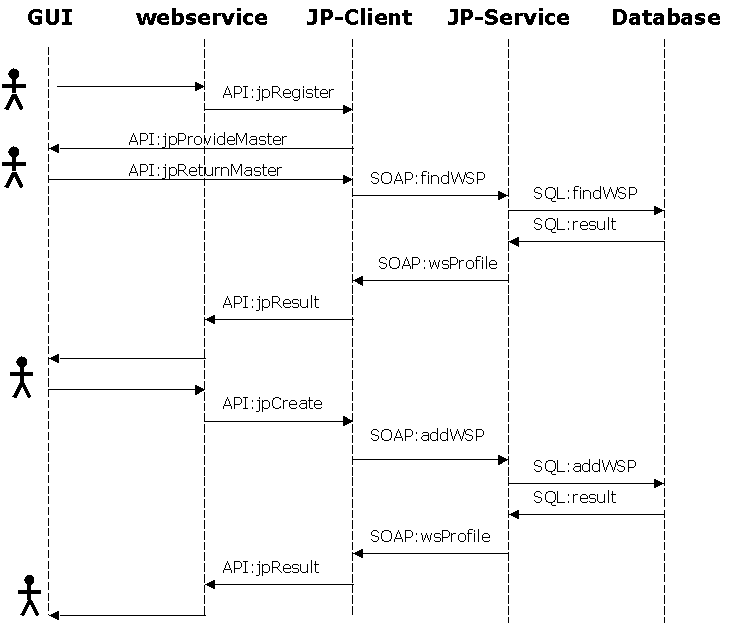
JPass Web-Service Specification:
Contents:
1. The services offering:
JPass offers some basic services for the USER like:
JPass also helps service providers:
JPass is a web service for web services. Confused? This document will enlighten you on what is meant. The JPass web service deviates from what is commonly understood about web services. It however is a web service, because it is defined and accessible using open web services technologies. One of the differences is however, that the JPass web service is only accessed when the user authorize access by means of a master password. Another difference is that the web service is running on the Users PC (At home or work) and is maintained by the user. No external instance, will manage your valuable information. When subscribing to a web service. the jpass web-service will create a new web-service profile and attach a web-service pseudonym to it.

2. WebService Profiles and Web Pseudonyms
Like me, you probably registered on a zillion websites, and
perhaps have no idea when and where you you did it. JPass keeps track for you,
you can do it manually or you can do it automatically if the web service
supports the JPass Client. For each website/service a new web-service profile is
created. Attached to the web service profile is the web-service pseudonym. This
can be your real identity or some identity you made up. This might seem
controversial functionality, but hey.... everybody fakes identities on the web
and NOway M$ is going to manage my real identity right? When accessing the
service you will log-on using a web service profile (WSP) which has been created
(automatically) for this service. JPass will keep a log on, when you created the
web service profile and when you logged on. 
Do service providers want a JPass client?
That's what I have been asking myself as well and my conclusion sofar is big YES. Why? it's simple, JPass compatible websites/services will offer additional ease of use. The user will be able to register and logon quickly, and manage the registration during the use of the service. The user will even be able to un-register. Many countries have laws on privacy and user should be offered the possibilities to un-register to a service and ask to remove personal information. So why not automate this process?
The service provider will receive the Web Service pseudonym return from the JPass Server. The interaction between the JPass Client and the JPass web service is the JPass client API. The JPass Client API is described further on.
// Need to look at security issues when the JPass client is embedded in the Web service. This could be solved by encrypting the // password with a private key by the client. The JPass server having the public key, will be able to decrypt and authenticate // the user. (similiar to how ssh works). Secure SOAP could perhaps also take care of this. This would prevent the web-service // from hijacking the JPass session and capturing the Master password.
JPass web technologies
The JPass services are offered using web services technologies SOAP, XML and WSDL. The SOAP protocol is the messaging method which calls/activates jpass services deployed on a JPass server. XML is used within SOAP to transfer JPass data and in the clients and servers to store and manipulate the data. WSDL is used to describe the JPass Service and make it available to public web services registries.
Webservice Profiles (WSPs)
The JPass Data contains information about websites/services and registration details. The principle data structure is called a "web service Profile". The complete web service Profile data structure is defined in the XML Schema:
The complete web service profile is broken down into consumable objects:
Web service profiles or components can be added, modified, retrieved etc..... In order to manipulate the web service profiles, several methods have been defined on the JPass Server.
Accessing the WSP database is done by the user and no one else, and can there for only be accessed with a master User & password.
Additional security options like, Authentication are being considered. (Signatures and Certificates).
JPass SOAP Server methods
As JPass uses SOAP to activate methods, each method will have a predefined SOAP message. procedures for registration of new webservices an logon to a webservice will use the one or more methods below. The SOAP messages correspond to the JPass Service methods.
SOAP Messaging or RCP:
The methods on the server can be defined as SOAP message calls or RPC calls. The SOAP messages are send to a user defined server in the JPass client.
| JPass SOAP method | JPass object | SOAP Envelope schema | Description | |
| Send | Result | |||
| getWSPlist | jpassUser.xsd, wsData.xsd | wsProfileList.xsd | getWSPlist.xsd | Request a list of WSP's from the JPass server. |
| findWSP* | jpassUser.xsd, wsProfile.xsd | wsProfile.xsd, null | findWSP.xsd | search for a WSP in the WSP list in the JPass server |
| getWSP | jpassUser.xsd, wsProfile.xsd | wsProfile.xsd | getWSP.xsd | Request a specific WSP using a WSP index from the JPass server. |
| addWSP | jpassUser.xsd, wsData.xsd | wsProfile.xsd | addWSP.xsd | Add a WSP to the list of this user |
| deleteWSP | jpassUser.xsd, wsProfile.xsd | - | deleteWSP.xsd | delete a WSP to the list of this user |
| logWSP | jpassUser.xsd, wsLog.xsd | - | logWSP.xsd | log a webservice entry in the WSP |
| setStatusWSP | jpassUser.xsd | - | setStatus.xsd | Change the WSP status to active/de-active |
* The findWSP method might become obsolete by the getWSP method.
Example of SOAP envelop schema:
<?xml version='1.0'?>
<xsd:schema xmlns:xsd="http://www.w3.org/2001/XMLSchema"
targetNamespace="http://jpass.sourceforge.net"
xmlns="http://jpass.sourceforge.net"
elementFormDefault="qualified">
<xsd:element name="getWSPlist">
<xsd:complexType>
<xsd:sequence>
<xsd:element ref="Master_User" />
<xsd:element ref="Master_Password" />
<xsd:element ref="wsData" />
</xsd:sequence>
</xsd:complexType>
</xsd:element>
<xsd:element name="Master_User" type="xsd:string"/>
<xsd:element name="Master_Password" type="xsd:string"/>
<xsd:element name="wsData">
<xsd:complexType>
<xsd:sequence>
<xsd:element ref="URL"/>
<xsd:element ref="ServiceCharge"/>
</xsd:sequence>
</xsd:complexType>
</xsd:element>
<xsd:element name="URL" type="xsd:anyURI"/>
<xsd:element name="ServiceCharge" type="xsd:string"/>
</xsd:schema>
Validation of SOAP message XML. The SOAP messages can be validated against their respective message schema. Validation by the client prior befor sending is advised (Is it?)
3. Procedures:
This chapter describes the basic procedures for:
Further development will include un-register from a webservice. This actually doesn't remove the WSP, but changes the status to passive.
Registration to a new web service:
When visiting a website/service for the first time, the user will often be access to register. The registration process with jpass will invoke the following SOAP messages:
findWSP
Check if the User has already registered on the website (Always OK to do right?) If no WSP is found the user gets the option to create a new WSP. if , there is a WSP. The webservice will use the method getWSP and check if it's active.
addWSP
Before addind the newWSP, the User get the option to get or register a new WSPpseudnyme
The added WSP is logged, the Webservice will provide the wsData object which contains information about the web service like URL, Category , Keywords, Country etc.....The wsData object is defined earlier.
Registration flow Diagram:
The flowdiagram below describes the interaction between the Jpass client, the Web Service and the JPass Server.

Logon to a web service:
When accessing a website/service the User will be asked to enter a valid Master UserID and Password an JPass Server.
findWSP
the WSP is matched against the users collection of WSP's (WSPList). if the WSP is found the JPass server returns the WSP index to the calling web service. The WSP contains the WSP pseudonym which will be used to login to the web service.
logWSP.
If the webservice accepts the user, a log entry will be sent to the JPass Server.
Databinding.
XML databinding technology can be used to generate the client methods from the